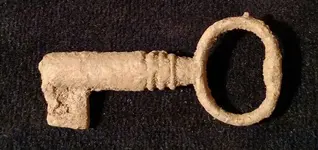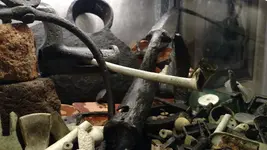OutdoorAdv
Bronze Member
- Joined
- Apr 16, 2013
- Messages
- 2,457
- Reaction score
- 3,351
- Golden Thread
- 1
- Location
- East Coast - USA
- 🥇 Banner finds
- 1
- Detector(s) used
- XP Deus,
GPX 4500,
Equinox 800,
AT Max
- Primary Interest:
- Metal Detecting
- #1
Thread Owner
I've been meaning to do this post for a WEEK now. This is from my hunt last Saturday (7/30) and I'm finally getting around to sharing it. This is also my first post in our new Colonial section.
I plan on sharing some of my posts only in here and not in "today's finds" to help build some content. I realize that 100% of this hunt was not colonial, but more than half is and the rest falls in the very early 1800's. So here it is.
I sifted a few sections before it got too hot and I had to retreat inside. My favorites were the two trunk keys and the cast white metal basket weave button. The "complete" pipe stem is a reconstruction and from 3 fragments that I found in one of the sections. AND... another bone handle to a fork. Sadly, the tines were no where to be seen, but it is still a nice artifact. Some incredible rose heads also turned up in this trip too.
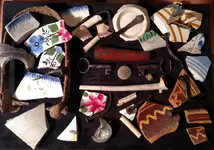

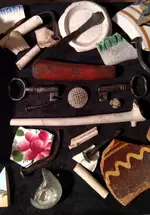
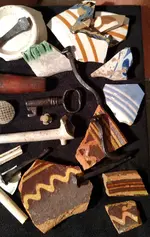
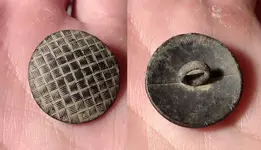
Now to the good stuff... the iron. I could tell right when these keys came out of the dirt that they would tumble and look amazing. They had very little oxidation from the well draining pit.
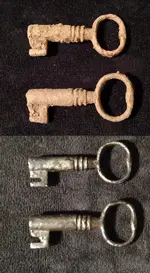
Click twice and zoom in on these.
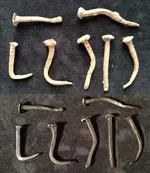
Here is the good iron after tumbling before wax. Every now and then I get into a pocket of rose heads in great condition. I think maybe it was fire tempering when a structure burned or something. Well, you can see hammer marks and even a crack in the Blacksmith's die used to forge the head of one of them. Pretty cool.
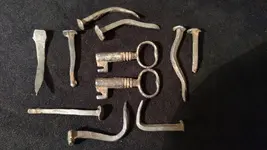
These two keys were found close to another key from this winter. All three got tumbled because they had very little oxidation. I really like the brown rust with steel peeking through on these.
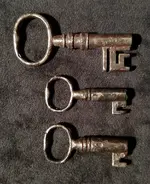
Seeing those three keys together made me want to pull all the keys from this site and do a group shot. All of these keys came from the same site over 16 months. All iron, no brass keys have turned up there yet. The three in the middle I tumbled, and the 4 on the outside I did electrolysis on. Finding keys never gets old
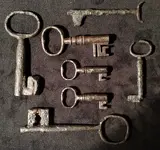
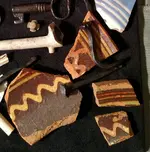
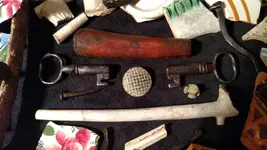
Thanks for looking everyone. Hopefully there was enough "Colonial" in there to make the cut.
I plan on sharing some of my posts only in here and not in "today's finds" to help build some content. I realize that 100% of this hunt was not colonial, but more than half is and the rest falls in the very early 1800's. So here it is.
I sifted a few sections before it got too hot and I had to retreat inside. My favorites were the two trunk keys and the cast white metal basket weave button. The "complete" pipe stem is a reconstruction and from 3 fragments that I found in one of the sections. AND... another bone handle to a fork. Sadly, the tines were no where to be seen, but it is still a nice artifact. Some incredible rose heads also turned up in this trip too.





Now to the good stuff... the iron. I could tell right when these keys came out of the dirt that they would tumble and look amazing. They had very little oxidation from the well draining pit.

Click twice and zoom in on these.

Here is the good iron after tumbling before wax. Every now and then I get into a pocket of rose heads in great condition. I think maybe it was fire tempering when a structure burned or something. Well, you can see hammer marks and even a crack in the Blacksmith's die used to forge the head of one of them. Pretty cool.

These two keys were found close to another key from this winter. All three got tumbled because they had very little oxidation. I really like the brown rust with steel peeking through on these.

Seeing those three keys together made me want to pull all the keys from this site and do a group shot. All of these keys came from the same site over 16 months. All iron, no brass keys have turned up there yet. The three in the middle I tumbled, and the 4 on the outside I did electrolysis on. Finding keys never gets old




Thanks for looking everyone. Hopefully there was enough "Colonial" in there to make the cut.



 .
.